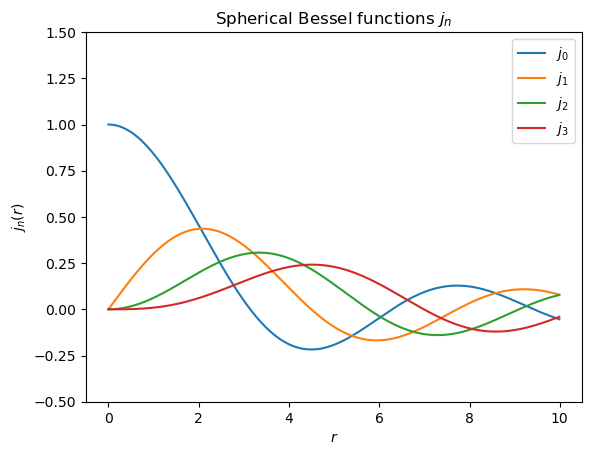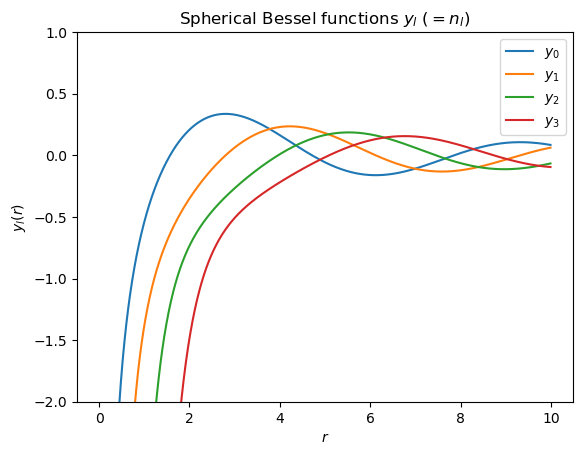Spherical Bessel function overview
Spherical Bessel function overview#
Here we look at graphs of the spherical Bessel functions and find the zeros, as needed for the three-dimensional spherical box (infinite well) problem.
import numpy as np
import matplotlib.pyplot as plt
from scipy.special import spherical_jn, spherical_yn
Make some plots of the lowest spherical Bessel functions
r = np.arange(0.0, 10.0, 0.01)
fig, ax = plt.subplots()
ax.set_ylim(-0.5, 1.5)
ax.set_title(r'Spherical Bessel functions $j_n$')
ax.set_xlabel(r'$r$')
ax.set_ylabel(r'$j_n(r)$')
for l in np.arange(0, 4):
ax.plot(r, spherical_jn(l, r), label=rf'$j_{l}$')
ax.legend(loc='best');

r = np.arange(0.0, 10.0, 0.01)
fig, ax = plt.subplots()
ax.set_ylim(-2.0, 1.0)
ax.set_title(r'Spherical Bessel functions $y_l$ ($ = n_l$)')
ax.set_xlabel(r'$r$')
ax.set_ylabel(r'$y_l(r)$')
for l in np.arange(0, 4):
ax.plot(r, spherical_yn(l, r), label=rf'$y_{l}$')
ax.legend(loc='best');

Look for zeros of the spherical Bessel functions \(j_{\ell}(\rho)\)
from scipy.optimize import root
# import numpy as np
# from scipy.special import spherical_jn
# import matplotlib.pyplot as plt
def spherical_jn_sensible_grid(n, m, ngrid=100):
"""Returns a grid of x values that should contain the first m zeros, but not too many.
"""
if (n > 0):
return np.linspace(n, n + 2*m*(np.pi * (np.log(n)+1)), ngrid)
else:
return np.linspace(n, n + 2*m*(np.pi), ngrid)
def spherical_jn_zeros(n, m, ngrid=100):
"""Returns first m zeros of spherical bessel function of order n
"""
# calculate on a sensible grid
x = spherical_jn_sensible_grid(n, m, ngrid=ngrid)
y = spherical_jn(n, x)
# Find m good initial guesses from where y switches sign
diffs = np.sign(y)[1:] - np.sign(y)[:-1]
ind0s = np.where(diffs)[0][:m] # first m times sign of y changes
x0s = x[ind0s]
def fn(x):
return spherical_jn(n, x)
return np.array([root(fn, x0).x[0] for x0 in x0s])
def show_spherical_jn_zeros(n, m, ngrid=100):
"""Graphical test for the above function
"""
x = spherical_jn_sensible_grid(n, m, ngrid=ngrid)
y = spherical_jn(n, x)
plt.plot(x, y)
[plt.axvline(x0, color='r') for x0 in spherical_jn_zeros(n, m)]
plt.axhline(0, color='k')
**The first argument to spherical_jn_zeros is the value of
ell = 0 # value of l (or n, if jn)
num_zeros = 5 # number of zeros to find
print(f' l = {ell} zeros:', spherical_jn_zeros(ell, num_zeros))
print(f'\n l = {ell} zeros (divided by pi): ',
spherical_jn_zeros(ell, num_zeros) / np.pi)
l = 0 zeros: [ 3.14159265 6.28318531 9.42477796 12.56637061 15.70796327]
l = 0 zeros (divided by pi): [1. 2. 3. 4. 5.]
